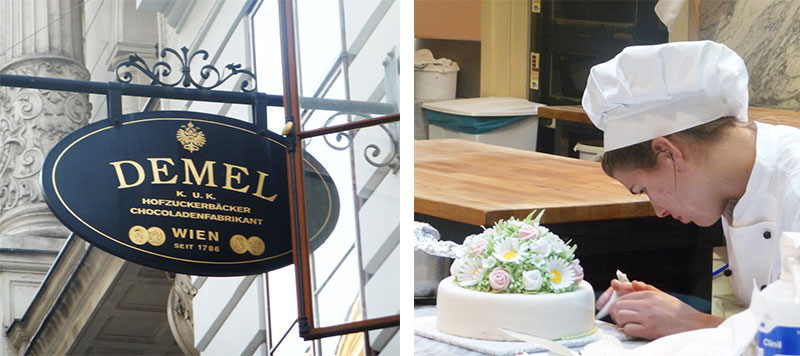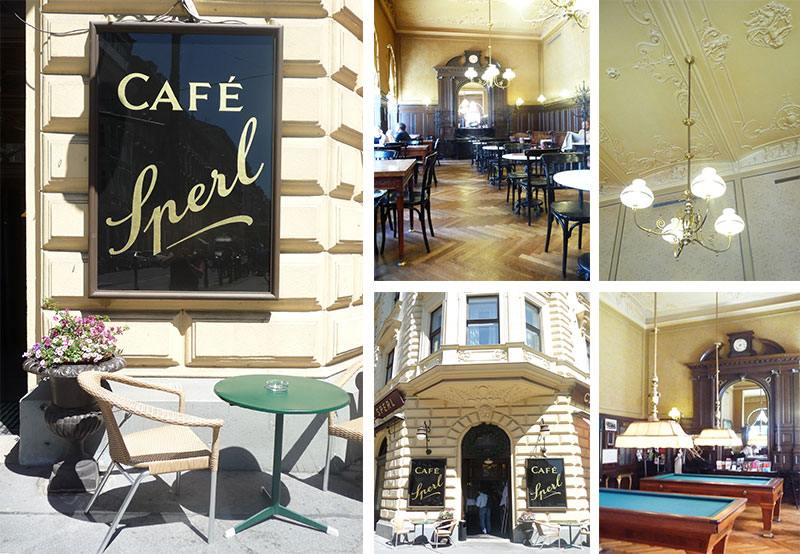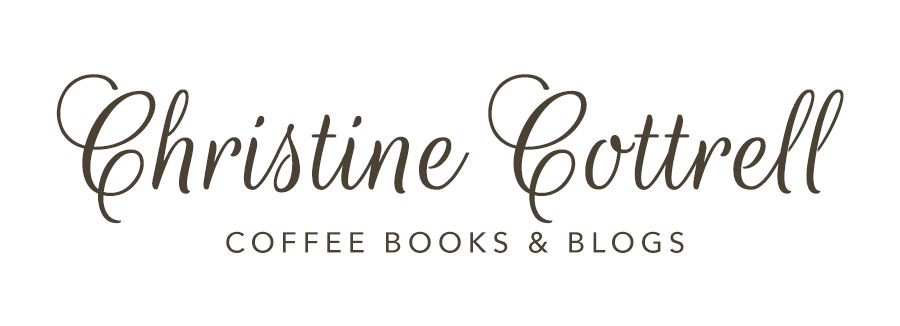
In 2011, the traditional coffee house culture of Vienna was listed by UNESCO for it’s Intangible Cultural Heritage – so described in the listing … ‘where time and space are consumed, but only the coffee is found on the bill’.
Of all the cities in the world, Vienna is the most known for it’s traditional cafe culture, representing elegance at all levels – from the architecture and ambience to the well-dressed Viennese and the cakes they enjoy. We visited many more traditional ones, but here’s our list of the best cafes in Vienna. See our subsequent list for the best specialty cafes in Vienna.

Cafe Sacher
No visit to Vienna would be complete without a visit to Café Sacher. Despite the crowds of Viennese and tourists, the ambience was quiet and refined. There were more chocolate cakes than you could ever imagine. Waitresses in frilly aprons darted from table to table and nothing seemed too much trouble. Large chandeliers and enormous vases of flowers made the elegant picture complete. As the Viennese do, we enjoyed our coffees with cream and shared a slice of the famous Sacher cake. To avoid the crowds, we suggest you go in the early evening or early morning (it’s OK to have chocolate cake for breakfast when in Vienna!).
Part of the Sacher empire has become a bit touristy, with the merchandising and all, and I have to admit, I gave in to the merchandise. So back at home, I occasionally enjoy my morning coffee in a cup with Hotel Sacher Wien written on the side. It’s a lovely memory!
A huge debate, starting in 1832, has been waged over who is the rightful owner of the Sacher Torte recipe. The secret to this cake’s success is locked away in a safe somewhere, but apparently its not only in the artful combining of ingredients; the chocolate must be at the exactly the right temperature and texture to pour the covering to the right thickness all in one go.

Café Demel
At Café Demel, another of our favourites, you have the choice of a busy room on the lower level or a quieter one above. We chose the latter and on the way up the stairs, found a little viewing platform where you can stop and see the pastry chefs and chocolateurs at work. Many have made their careers at Café Demel since it started in 1786. A small museum is part of the café with old bakery, chocolate and confectioners’ artifacts on display

Wherever you turn, there’s an enormous display of cakes, biscuits and pastries, all ornately hand crafted – and an enormous drinks menu to match. Our choice was a wedge of layered walnut and coffee cake with a couple of espressos. Apparently the reason there are so many cakes and pastries in Vienna, is because all the different coffee houses vied with each other in times past to produce ‘the best’. Recipes were kept as guarded secrets and are still often locked away by the owners.

Cafe Schwartzenburg
Café Schwartzenburg features the traditional ‘look’ of panelled timber walls, chandeliers, brown leather upholstery, beaten brass and marble tabletops – and the finest of china. We enjoyed yet another coffee but resisted the cakes, but admiring them once more from the enormous range.

One thing particular to most Viennese cafes is the humble newspaper. They’re kept neat and tidy clamped into their long timber handles. A nifty idea that’s common practice in many European cafes; I’ve often wondered why it never took off in other parts of the world. At Café Schwartzenburg, there’s a particularly large selection of international papers and magazines, inviting customers to stay for however long they like.

Cafe Diglas
Situated in a prime spot in Central Vienna just near St Stephens church, you’ll find Café Diglas. The original location was opened in 1875 by Franz Diglas; and it’s now one of four different establishments that share the Diglas name. In the early days it attracted a good clientele of royals and artists, most notable being the classical composer Franz Lehar who had his special spot where he liked to sit. The Diglas brand spans three generations with the grandson of the original owner now running the business. It has a particularly large range of cakes, biscuits, Viennese buns and puddings – all on display as you walk in the door, where you can often see the staff putting on the finishing touches. Our eyes were drawn to the little pink signature cakes with ‘D’ for Diglas. Most coffee experiences in Vienna come served on a single tray for each person. And there’s always a glass of water.

Cafe Central
The ‘grand dame’ of all cafes would have to be Café Central, breathtaking with its marble columns, vaulted ceiling and chandeliers. Strauss music amplified the atmosphere when we were there. The piano player greeted us with a nod and ‘herr ober’, our formally clad waiter, whizzed us to an intimate table for two, perched menus in front of us while whipping large, starched napkins onto our laps – all before we could draw our second breath. This art of ‘meeting and greeting’ has obviously been refined over decades and was a delight to experience. We enjoyed some white asparagus, pork belly and schnitzel – with piles of potatoes and a fine bottle of local wine. Dessert was the traditional ‘apfel strudel’ – with lashings of cream.

Café Sperl
Second only to Café Central is Café Sperl with its cosy, homely atmosphere – called ‘gemutlichkeit’ in German. You will be greeted at the door as if you’re visiting a friend and you’ll find the comforts of an elegant living space with pressed metal ceilings, bentwood chairs and marble tabletops. Newspapers, games and billiard tables are all provided for the enjoyment of guests. The coffee and cake are served in typical Viennese style on a silver tray, with a starched napkin and small glass of water. Café Sperl has been used in movies, including Before Sunrise. It’s also featured in a DVD of Strauss music, Johann Sebastian Strauss being possibly the most well known of Viennese residents from the past.

Café Gloriette
Quite a way out of town is a place not to be missed. High up on the hill beyond the gardens and the duck pond of Schonbrunn Palace is Café Gloriette. It’s been a public cafe since 1996, but it was once where the ruling Hapsburg royals went to relax. Built by Empress Maria Theresa in 1775 to celebrate the end of the Prussian War, a generation later, Emperor Franz Josef and his wife Elisabeth often enjoyed their breakfast there. A bit of effort, particularly on a hot summer’s day, you can walk there from the palace – just as Franz and Elisabeth presumably did each morning.

With a large ornate room in the centre and colonnaded walkways either side from which you can admire the picturesque views to the palace and city, the Gloriette provides a magnificent setting for a special event such as a wedding or cocktail party.
 Sissy Cake
Sissy Cake
The specialty at the Gloriette is the Sissy cake, named after Empress Elisabeth who was affectionately known as ‘Sissy’. Designed as an individual cake for each person, it’s covered in jam and ganache with a sprinkling of candied violets on top. After the strenuous walk up the hill you certainly earn the right to one!
The cafe is large and serves food all day long. On weekends and public holidays, you can book into the Sissy breakfast buffet – a spectacular treat of all things Viennese with a Sissi cake included to take away in a box.
Although most coffee houses in Vienna are refined, elegant establishments steeped in tradition, you will find a few ‘quirky’ ones among them. Two in particular fit this category …
Aida
You won’t be able to miss the pink and brown of the Aida cafes dotted around the city. Originating in 1913, there are nearly 40 of them now. The owners were possibly the first to bring espresso machines to Vienna. Staff are mostly female and they all wear pink 50’s style skirts, pink ankle socks and pink bows in their hair. You’ll find pink neon lights, pink plastic chairs along with plenty of pink icing, pink chocolate and anything else foodwise that’s pink.
Cafe Hawelka
Opened by Leopold and Josefine Hawelka in 1939, the most iconic of the alternate Viennese cafes would have to be Cafe Hawelka. You probably wouldn’t go inside unless you knew that it’s a Viennese institution, because it retains the original decor and furnishing to this day – with an espresso machine the only thing that’s been new in all its history. Josefine was baking the cafe’s specialty Buchtein until she died in 2005 and Leopold was still greeting guests at the entrance until he died in 2011 at the age of 100. The cafe remains in the family with their son Gunther and grandsons Amir and Michael now in charge.
Café Museum
We dropped into Café Museum on our way to the Naschmarkt on our last evening in Vienna. It’s a bit more modern than the rest with its Ferrari-red velvet couches matching it’s La Cimbali espresso machine. We were to realise that La Cimbali is the most popular espresso machine in Vienna. Attracted by the display of delicious side salads in the counter cabinet, we ordered some cold drinks to catch up on some news while waiting for our meal.
On all the cafe menus, I’d had my eye on the Maria Theresa, a coffee served with orange liqueur and cream. It has its origins with Empress Maria Theresa who presumably enjoyed one every now and then. I don’t know what made me do it, (running out of time to satisfy the curiosity, I guess) but then and there I ordered one!
The waiter made a bit of a fuss and I’m sure he added extra liqueur and cream. The taste sensation of sipping coffee, orange and alcohol through a thick layer of cream while biting into a little orange zest was a memorable experience – even if it’s a never-to-be-repeated one! It was very rich and laden with caffeine, so I didn’t sleep until the early hours of the morning!

